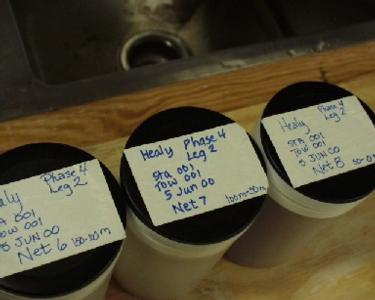5 June, 2000
The MocNess Monsters
June 5, Monday
Bulging black eyes stared me down. The transparent, jelly-like creature
writhed menacingly back and forth. Suddenly it lunged towards me, its sharp
fangs snapping ferociously.
I stepped away from the microscope and blinked my eyes a few times. The
arrow worm didn't look quite as threatening from this angle. Only 4
centimeters long, it looked like an earthworm made of glass.
Viewed under the microscope, though, it looked an awful lot like those
mythical sea monsters from sailors' tales of the deep. Inside the arrow
worm's transparent body, I could make out the remains of its last meal. The
reddish outlines of tiny shrimp-like creatures called copepods were easy to
see.
Arrow worms and copepods are two kinds of zooplankton found in the ocean.
Have you ever heard of krill? That's another kind of zooplankton.
Zooplankton are small animals that range in size from microscopic to several
centimeters long. These critters are extremely important because they are
eaten by fish, shrimp, and large marine animals like whales. It takes a lot
of tiny zooplankton to satisfy a hungry whale!
Earlier in the evening, Susan and I had helped Peter Lane, a marine
biologist from the University of Miami, capture these critters in the
MOCNESS. MOCNESS is an acronym that stands for "Multiple Opening and Closing
Nets and Environmental Sampling System". It consists of a frame with a
series of several long nets that are towed behind the ship. Each net
captures zooplankton at different depths. The critters are then brought into
the laboratory where Peter examines them.
First Peter counts the copepods. Copepods look like miniature versions of
their cousins, the shrimp. They can grow up to 8 millimeters in length, but
most are smaller than that. Because they are so tiny, it takes a long time
to count them. So Peter divides the copepods into 10 equal groups, or
samples. He counts all of the copepods in one sample, and then multiplies by
10. If he finds 500 copepods in one sample, then Peter calculates that there
were 5,000 copepods caught in that net. It usually takes a whole day just to
count one or two samples!
Then, depending on the type of experiment he is doing, Peter will look at
different things. He might note the age of the copepods, their size, or
whether they are male or female.
All of this information is recorded in a journal. The zooplankton are then
poured into carefully labeled jars where they are preserved for further
studies.
It takes a lot of patience to be a scientist, but the result is worth it!
Peter's work with copepods and other zooplankton help scientists understand
more about life in the ocean. The more knowledge we have, the better we can
protect our oceans.
To find out how the MOCNESS works, click on Susan's page:
Susanís Entry
Today.
DAILY DATA LOG (6/05/00)
Air Temperature: 36 degrees F
Clear skies, sunny
Latitude 57N
Longitude 55W
Sunrise 5:04
Sunset 10:33
Actually, it never got DARK last night. For an hour or two in the middle of
the night, it was more like dusk than night. But even at midnight you could
see light on the horizon.

These samples are lined up in order of the depth they were collected. Can you see which one has the most zooplankton?

Each sample is clearly marked so that the scientists will know where and when it was collected.

Sunrise 5:04 and Sunset 10:33 Actually, it never got DARK last night. For an hour or two in the middle of the night, it was more like dusk than night. But even at midnight you could see light on the horizon. This picture was taken after midnight!
Contact the TEA in the field at
.
If you cannot connect through your browser, copy the
TEA's e-mail address in the "To:" line of
your favorite e-mail package.
|
